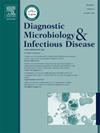对来自SPECTRA的危重患者的头孢唑烷/他唑巴坦的处方模式和有效性的真实世界调查
IF 2.1
4区 医学
Q3 INFECTIOUS DISEASES
Diagnostic microbiology and infectious disease
Pub Date : 2025-02-08
DOI:10.1016/j.diagmicrobio.2025.116737
引用次数: 0
摘要
背景:在全球重症监护病房治疗的重症监护患者中,研究了头孢唑烷/他唑巴坦(C/T)的实际使用情况。真实世界分析(SPECTRA)是一项跨国、回顾性观察性研究,对2016年至2020年接受C/T治疗的617名成年人进行了研究。对重症监护患者进行人群相关临床、治疗相关和微生物学特征、资源利用和临床结果评估。结果在这个SPECTRA重症监护队列中(n=298), 81.5%有≥1个合并症。常见感染部位为呼吸道(50.0%)、皮肤/伤口/组织(21.1%)、血液(13.7%)和尿液(10.3%);常见致病菌为铜绿假单胞菌(89.7%);66.7%耐多药)、克雷伯氏菌(6.9%)和大肠杆菌(6.4%);51.7%的患者接受C/T作为三线/挽救性治疗。30天再入院率为3.4%(全因)和1.7%(感染相关)。总体临床成功率为53.4%(95%可信区间:47.5%至59.1%),一线C/T(62.2%)高于三线(45.5%)。全因住院死亡率为35.6%;感染相关死亡率为13.8%。结论在这个跨国、高风险的队列中,尽管患者临床复杂且晚期进行了C/T干预,但大多数患者都获得了有益的结果。这些结果支持在重症监护环境中使用C/T治疗多种革兰氏阴性病原体。由于回顾性设计,试验注册不适用。本文章由计算机程序翻译,如有差异,请以英文原文为准。
A real-world investigation into prescribing patterns and effectiveness of ceftolozane/tazobactam among critically ill patients from SPECTRA
Background
Ceftolozane/tazobactam (C/T) real-world use was examined in a global population of critical care patients treated in intensive care unit settings.
Methods
The Study of Prescribing patterns and Effectiveness of Ceftolozane/Tazobactam Real-world Analysis (SPECTRA) is a multinational, retrospective observational study of 617 adults treated with C/T conducted between 2016 and 2020. Population-associated clinical, treatment-related, and microbiologic characteristics, resource utilization, and clinical outcomes were assessed in critical care patients.
Results
In this SPECTRA critical care cohort (n=298), 81.5% had ≥1 comorbidity. Common infection sites were respiratory (50.0%), skin/wound/tissue (21.1%), blood (13.7%), and urine (10.3%); common pathogens were Pseudomonas aeruginosa (89.7%; 66.7% multidrug resistant), Klebsiella spp. (6.9%), and Escherichia coli (6.4%); 51.7% received C/T as third-line/salvage therapy. Thirty-day readmission rates were 3.4% (all cause) and 1.7% (infection related). Overall clinical success was 53.4% (95% confidence interval: 47.5% to 59.1%) and was greater with first-line C/T (62.2%) versus third line (45.5%). All-cause in-hospital mortality was 35.6%; infection-related mortality was 13.8%.
Conclusions
In this multinational, high-risk cohort, most patients had beneficial outcomes despite their clinical complexity and late intervention with C/T. These results support C/T use against a wide range of Gram-negative pathogens in critical care settings.
Trial registration
Not applicable due to retrospective design.
求助全文
通过发布文献求助,成功后即可免费获取论文全文。
去求助
来源期刊
CiteScore
5.30
自引率
3.40%
发文量
149
审稿时长
56 days
期刊介绍:
Diagnostic Microbiology and Infectious Disease keeps you informed of the latest developments in clinical microbiology and the diagnosis and treatment of infectious diseases. Packed with rigorously peer-reviewed articles and studies in bacteriology, immunology, immunoserology, infectious diseases, mycology, parasitology, and virology, the journal examines new procedures, unusual cases, controversial issues, and important new literature. Diagnostic Microbiology and Infectious Disease distinguished independent editorial board, consisting of experts from many medical specialties, ensures you extensive and authoritative coverage.

 求助内容:
求助内容: 应助结果提醒方式:
应助结果提醒方式:


